
Looking to the future article from the garden march 2016

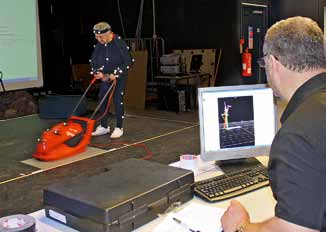
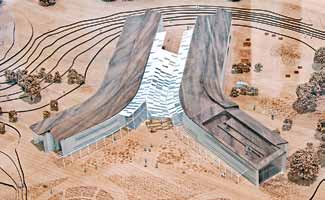

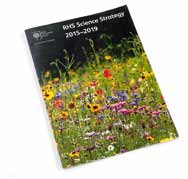
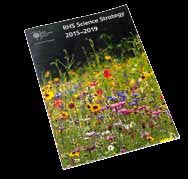
RHS Science developments
RHS Science Strategy
By sharing and improving RHS horticultural
research the new Science Strategy aims
(via four key themes) to continue to guide
gardeners and growers. Using the vast,
ever-growing collections of plants,
insects, pathogens, books and art in its
possession, the RHS can maintain
its place as a leading contributor
to global horticultural science. The Society will aim to
continue to grow and invest in research. This will help
Researchers at Coventry University (above), part funded by the
to maintain the health of our plants and the beneficial
RHS, studying how people use different muscles when gardening.
organisms they support, safeguarding UK biodiversity
A new horticultural science centre and knowledge bank (below)
(in the process) through improved stewardship of nature,
will be built in the Hilltop area at RHS Garden Wisley, Surrey.
with schemes such as Perfect for Pollinators.
The four key themes in the strategy are:
1 a global knowledge bank for gardening and garden plants
2 plant heath in gardens
3 gardening in a changing world
4 plant science for all: people, plants and planet
For more information about the work of the RHS Science
Alistair Griffiths, RHS Director of Science and Collections
(left), and RHS Director General Sue Biggs discuss the
team – and to download a copy of the strategy – visit:
RHS Science Strategy with The Garden Editor Chris Young.
Looking to Sitting in the Council Room legacy under which she and her Last autumn, the Society unveiled
RHS Gardens Wisley, Harlow Carr and
at the RHS headquarters in
team work. ‘Science in particular is
the RHS Vision: a document that sets
Hyde Hall. In addition, the announce-
Westminster, London is
absolutely crucial to our work,' she
out the challenges that everyone
ment in October 2015 of a fifth garden
always an experience.
says. ‘We must make science more from individual gardeners, the wider
(RHS Garden Bridgewater, Greater
the future More than just a meeting visible, and remind members and horticultural community and the
Manchester, opening 2019) and
room, it embodies so much of the
visitors that without our scientific
global population face in relation to
increased community outreach
longevity of the Society; panelled
foundations we wouldn't be able
plants and food. The eight key issues
across the UK are some main
walls, yes, but so too portraits and
to give the right information in the
– such as building stronger and
activities. As Sue says, ‘Our vision is
photographs of significant members
right way, to the right people.'
happier communities, or protecting
to enrich everyone's life through
from the organisation's past. The late
The original purpose of the
plant health – link directly to the
plants, and make the UK a greener
Lord Aberconway (of Bodnant
organisation, ‘the encouragement
current Key Investment Projects
and more beautiful place. It is hugely
The 21st century poses new
Garden) and Sir Richard Carew Pole
and improvement of the science,
which will deliver a £160 million
aspirational. With our increasing
horticultural and societal challenges
(of Antony in Cornwall) oversee
art and practice of horticulture in
change to both the charitable
membership and all the different
for our planet, as well as for the UK's
contemporary conversations. But
all its branches', is as relevant
external work of the RHS (through
people we work with, we really
centre stage is Sir Joseph Banks (1743–
today as it was on 7 March 1804
communities and education),
believe the RHS can make a material
gardens and gardeners. The RHS
1820), botanist, natural historian and
(when it was founded).
and substantial redevelopment of
difference to the lives of people
recognises the importance of
promoter of the sciences – and one
– through our passion for plants.'
horticultural science in meeting these
of the founding members of the Horticultural Society of London.
Science in action
challenges, and has pledged major
Fast-forward to 2016, and the
Our vision is to enrich everyone's life
Underpinning much of the vision is
investments to prepare for the future
interests of these horticultural greats
the work of the science team, led by
– gardens, botany and science – are
through plants, and make the UK
Dr Alistair Griffiths, RHS Director of
Author: Chris Young, Editor, The Garden
still at the core of the RHS. Director
Science and Collections. Soon after
General Sue Biggs is well aware of the
a greener and more beautiful place
the RHS Vision was launched,
48 The Garden March 2016
March 2016 The Garden 49
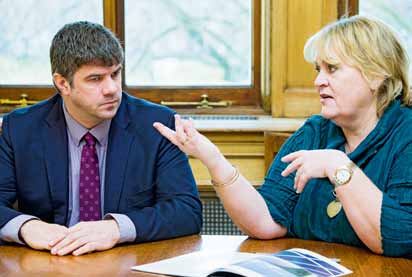

RHS Science developments
Launch of the RHS VisionIn October 2015, the Society unveiled its new RHS Vision. This outlines the issues both affecting home gardeners and the wider plant and horticultural industry, and shows the way in which the RHS will respond to these problems.
Sustained future investment of £160 million will help to
improve the science and art of horticulture and promote its joy and importance to all – from Britain in Bloom to the work of the RHS Campaign for School Gardening.
Changes to RHS Gardens, including
the flagship site at Wisley, Surrey, and a
new site in Greater Manchester (RHS
Garden Bridgewater; opening 2019), will
bring horticulture to many more visitors.
✤ For a copy of RHS Vision, visit: www.rhs.
org.uk/rhsvision or call 01733 294664.
We really believe the RHS can make
comprises 30,000 different daffodils. It is known that N. ‘Carlton', a bright
a material difference to the lives of
yellow, large-cupped cultivar, has high levels of galantamine. By getting
people – through our passion for plants the name and plant description right,
and in holding a specimen in the RHS herbarium, the Society can ensure the
Alistair published the RHS Science
area) typifies the link between
right plants go into potential breeding
Strategy 2015–2019. This document,
science and gardening. ‘If we can
that could enhance the levels of
the first forward-looking science
select mixtures of plants that can cope
galantamine produced. ‘It is exactly
review for many years, outlines four
with pollution or difficult growing
this sort of knowledge that the RHS
key scientific areas of focus (see p49).
conditions, for example, then we
has; we can help with so much more
It considers issues such as knowledge
actively support Greening Grey Britain
than people may have expected.'
of garden plants, plant health and
by giving sound advice,' says Alistair.
This collaborative and philanthropic
making science relevant to people
From front gardens to green roofs,
approach is very much part of both
and the planet. ‘The value of
street trees or windowsills, authori-
Sue's wider RHS Vision, and Alistair's
horticultural science cannot be
tative knowledge from RHS scientists
science work. The benefits for RHS
underestima ted,' Alistair says. ‘With our
can have substantial benefits.
members and the wider community
The RHS herbarium
investment in scientific research we
But the challenge, as for all large
specimen (above)
is clear. Implementing much of this
will develop a much stronger evidence
organisations, is to get the message
of Narcissus
work and explaining it to people will
base that helps to improve the lives of
across. From PhD scientific research
‘Carlton', known to
be a challenge but, with a clear
have high levels of
gardeners and the environment.'
(currently the RHS is funding 10,
galantamine. The
direction, the Society's forebears
So what does that mean for home
including one helping Sheffield and
RHS can ensure this
would hopefully have been proud of
cultivar is correctly
gardeners? According to Alistair, it
Virginia universities determine if
the continued work of RHS science.
gives a sound base to the Society's
planted-up front gardens have a
We may yet see a knowing twinkle
knowledge bank – which then gets
positive impact on residents'
from Banks's eye as he presides over
imparted to different audiences. ‘With
wellbeing) to engaging children
many more of these conversations.
the right taxonomy [the identification,
through the Rocket Science project
description, classification and naming
(see p75), science has a role. Alistair
of plants], we can understand which
says, ‘As we better understand what
plants are best suited to different
plants there are and how they relate
Listen: RHS podcast
locations; we can grow those plants
to each other, it will help us and
in our gardens; and as a result we not
others do their scientific research.'
Fortnightly RHS gardening podcasts offer a lively
only beautify an area but also better
One example he cites is the role of
magazine approach to the latest news, highlights and enquiries to the RHS. For a special science-based
use and conserve the genetic
Narcissus and the medical industry.
podcast, including this interview with RHS Director
diversity of garden plants,' he says.
Daffodils contain the chemical
General Sue Biggs and RHS Director of Science and
The Society's Greening Grey Britain
galantamine, which is used for the
Collections Alistair Griffiths, download the latest
campaign (in which people are
treatment of Alzheimer's disease.
edition. ✤ Visit: www.itunes.com and search RHS
encouraged to turn over some paving
The RHS maintains the International
Gardening Podcast; or www.rhs.org.uk/podcast
or tarmac and plant up a small green
Cultivar Register of Daffodils, which
50 The Garden March 2016
Source: https://www.rhs.org.uk/about-the-rhs/publications/magazines/the-garden/2016-issues/March/looking-to-the-future-rhs-science-strategy
Was sind Parkinson-Syndrome? Parkinson-Syndrome gehören zu den Bewegungsstörungen Unter Parkinson-Syndrome fasst man Störungen des cholinergen und dopaminergen Systems in den Basalganglien zusammen Die Störung dieser Neurotransmitter-Systeme führt zu den für Parkinson-Syndromen klassischen o Akinese o Rigor o Tremor o Posturale Instabilität
Bioenergy RIBOSE & Caffeine Solution for Decreased Fatigue/Increased Alertness/Elevated Mood Higher Sport Performance Cognitive/Mental Health Cardiovascular Health D-Ribose, or simply ribose, is an aldopentose (5-carbon monosaccharide with an aldehyde functional group) which is used by all cells of the body. Ribose is an essential structural component of energy currency Adenosine triphosphate (ATP) as well as several other compounds that are critical to metabolism. Ribose also comprises the backbone of RNA and is related to DNA. Forming ribose in heart and muscle is a slow process which, in turn, delays energy recovery when energy pools have been depleted by disease or exercise. Ribose restores and maintains depleted energy reserves. Ribose is often marketed as a supplement for boosting energy and reducing fatigue in:












